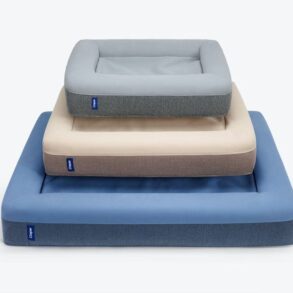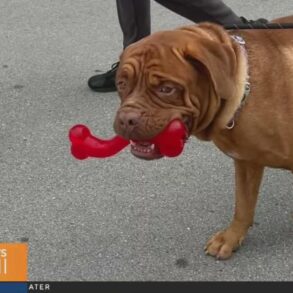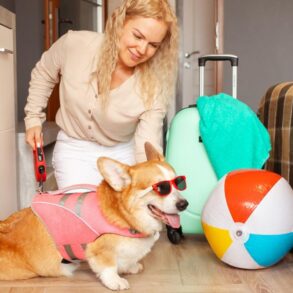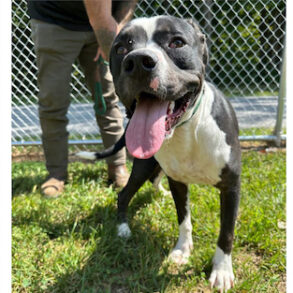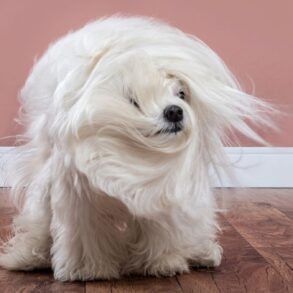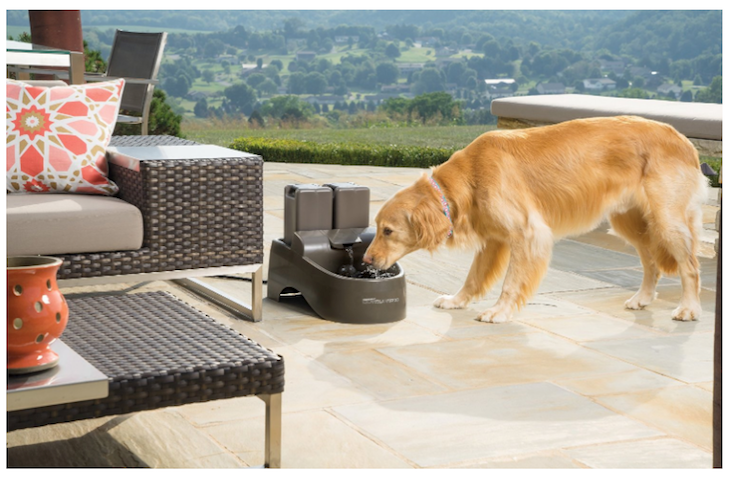
Do you have a dog that shows little interest in their water bowl but will enthusiastically drink from the toilet if given the opportunity? Maybe you want to encourage them to take on more fluids to prevent the risk of dehydration on hot days or to help manage a medical condition.
Pet water fountains use a motorized pump and filter to provide a continually circulating, consistently cool stream of running water. They’re a popular option for cats who regularly lap from the faucet. But is it worth getting one of these devices for dogs, or is it better to stick with a traditional dog bowl?
Will A Pet Fountain Encourage My Dog to Drink More?
The most common praise for pet fountains is that running water encourages dogs and cats to drink more. However, don’t buy one of these bowls expecting your dog to instantly start lapping up more liquids. The anecdotal evidence supporting this hypothesis relates to cats, who drink from faucets more often.
“I’m unaware of evidence supporting the theory that dogs prefer running water,” says Carlo Siracusa, DVM, an Associate Professor of Clinical Animal Behavior and Welfare in the School of Veterinary Medicine at the University of Pennsylvania. It’s also worth noting that even the limited studies on cats don’t prove that using circulating water bowls significantly affects water intake.
Dr. Siracusa says various factors influence dog water drinking habits, including early experiences, diet, temperament, and environmental factors, such as health conditions and climate. This means all dogs have their own preferences, and some are drawn to running water. If your dog enjoys drinking from a garden hose, an outside tap or a park water feature, then a pet fountain may encourage them to drink more.
Research does suggest that dogs prefer drinking cool water. While it’s possible to add ice cubes to your dog’s bowl or regularly refresh tepid water, a pet water fountain could be a convenient option. It’s continual water circulation helps maintain a consistent temperature.
Then there’s the fact that pet fountains filter the water. While they might not remove contaminants the way under-sink, faucet-mounted or countertop filters will, they still get rid of food particles, hair and other larger debris that could make water less appealing to your dog.
Is a Pet Water Fountain Right For Your Dog?
A pet water fountain isn’t an essential purchase for your pet. If your dog already drinks enthusiastically from their bowl, it could just be a costly item cluttering your kitchen floor. However, if they prefer running water sources, or you just want to allow your dog to make their own choices, investing in one of these devices could be worth it.
Dr. Siracusa suggests making different water sources available in multiple locations to see what your dog plumps for. “This is even more important in a multi-dog household, where dogs may compete for access to resources,” he says.
However, be aware that some dogs won’t be fans of pet fountains. They are bulky, and the pump generates noise, which might be off-putting—especially for fearful dogs. Pet water fountains also cost significantly more than traditional water bowls, their complex construction means cleaning is more of a chore, and you’ll have to change the filter regularly.
Even if your dog is a fan of pet water fountains, don’t ditch their old bowl. As well as giving your dog options, keeping this clean and topped up with fresh water means it acts as a backup if you experience a power outage or the pump breaks down on the fountain.
What To Consider If You’re Purchasing a Pet Water Fountain?
If you’re planning on giving a pet water fountain a whirl, consider the following features:
-
Material: Stainless steel pet fountains are the most hygienic option, and are super tough. Ceramic fountains are also available, but they can be heavy and more fragile. Pet water fountains are commonly made from plastic. While they’re lightweight and economical, research suggests plastic bowls more readily accumulate bacteria and can cause skin reactions in some dogs.
-
Technology: Some pet water fountains have apps that alert you when the filter needs changing, water levels are low, or it’s time to deep clean. Some pumps are wireless, reducing safety risks and offering more flexibility for where you position the fountain.
-
Cleaning: Select an easy-to-assemble model with just a few parts for maximum convenience. Some fountains have dishwasher-safe parts.
-
Size: A model designed for a cat might only suit toy dog breeds. Go big if you have a multi-dog household or large breeds to ensure your pets stay sufficiently hydrated throughout the day.
-
Noise: Most pet water fountain pumps produce a slight hum. If you have a noise-sensitive dog, select a model that operates quietly. You still might have to help them get used to it with gradual and positive introductions.
See Your Vet If Your Dog Isn’t Drinking Enough
“A healthy dog with consistent access to multiple sources of fresh water should be able to self-regulate,” Dr. Siracusa says. However, if you’re concerned your dog isn’t drinking enough water, regardless of whether they’re using a pet water fountain or not, consult with a veterinarian.
“A veterinarian can help determine what should be expected of a dog with specific characteristics and diet,” Dr. Siracusa says. “If a dog is showing atypical drinking patterns, either drinking more or less water than expected, I will suspect an underlying behavioral or physical problem.”
Dehydration in dogs can be a serious health risk, and it’s not something to ignore. “It will cause an electrolyte imbalance, negatively affecting the urinary and cardiocirculatory systems,” Dr. Siracusa says. “Kidney disease, urinary tract disease, hypovolemic shock, and heatstroke can be dangerous consequences.”
Other Ways to Help Your Hound Stay Hydrated
A pet fountain might encourage your dog to drink more water, but there are easier, less expensive ways to keep your pet hydrated. Encouraging your dog to increase their water intake is especially helpful if they have a medical condition putting them more at risk of dehydration, they’re a breed more prone to heatstroke, or you live in a hot climate.
If your veterinarian rules out anything concerning, consider these additional ways to help keep your hound hydrated:
Whatever bowl you choose, ensure your dog always has access to fresh water. Research suggests the dog bowl is one of the dirtiest household items. Replacing water and cleaning the bowl or pet fountain daily helps prevent a buildup of bad tastes, debris and bacteria.
This post was originally published on this site be sure to check out more of their content.


















